Monday, June 28, 2021
Book Review: Earthblood and Other Stories
Saturday, June 26, 2021
Robo Hunter: Verdus
The 'Verdus' storyline of 'Robo-Hunter' initially appeared in 2000 AD from prog 76 (August 5, 1978) to Prog 112 (May 12, 1979) with scripting by John Wagner and illustrations by Ian Gibson (with the initial issues handled by Jose-Luis Ferrer).
This 136 - page compilation of the complete 'Verdus' comics was issued by DC in 2004, part of a rather short-lived partnership with the UK's Rebellion publishing house to issue reprints of selected 2000 AD titles for the American comics market.
'Robo-Hunter: Verdus' has the dimensions (7 1/ 2 x 10 1/4 inches) of the American graphic novel, which means it was reduced from the UK format (9 inches wide x 11 inches).
Wednesday, June 23, 2021
The ruins of New York City from Planet of the Apes magazine No. 7
by Alfredo Alcala
Saturday, June 19, 2021
At McKay's Books
Of course, the never-ending construction work on repaving Route 28 in Manassas, from Route 619 to Godwin Drive, added another 15 minutes to the drive there (and 20 minutes to the drive back). So each way, it was closer to two hours of driving.
Crouching and squatting among the shelving at McKay's left me with a thin coating of sweat.....I can't figure out how the women patronizing McKay's wear long-sleeved tops because it's too 'cold' inside........
But my perspiration yielded rewards: I was able to find, nestled among copies of 'Bitch Planet' and 'Black Science' graphic novels, some rare, vintage Euro comics for reasonable prices (i.e., under $5 each):
XIII is a French-language adventure series that emerged as one of the more popular and celebrated bande dessinee of the 1980s.
Wednesday, June 16, 2021
Book Review: Bolo Brigade
‘Bolo Brigade’ (376 pp.) was published in May, 1997 by Baen
Books. The cover artwork is by C. W. Kelly.
Following his death in 1993, the ‘Bolo’ supertank franchise
of Keith Laumer continued under the aegis of Baen Books, who issued reprints of
Laumer’s stories and novels along with new entries in the franchise.
William H. Keith Jr. (b. 1950) is an American author with
extensive short story and novel credits for a number of licensed properties,
including ‘Cybernarc’ (as by ‘Robert Cain’), ‘Battletech’, ‘Doctor Who’, and
‘Buck Rogers’. During the 2010s Keith, Jr. has been active in writing entries
for the ‘Star Carrier’ line of eBooks for the Harper Voyager imprint of Harper
Collins.
‘Bolo Brigade’ is set on the planet Muir in the Strahan
Cluster, a system located on the edge of the spiral arm of
the Milky Way galaxy. As the novel opens, Lieutenant Donal Ragnor is taking
command of the planet's major defense unit: the eponymous Bolo brigade. For Ragnor, whose checkered history includes
a court-martial, the posting to Muir is a career dead-end, one designed to
place him out of sight and out of mind.
Nonetheless, Ragnor remains dedicated to the military and his mission, and he promptly moves to discipline the lackadaisical soldiers who are responsible for the maintenance of the two Bolo tanks housed in the arms depot in the capital city of Kincaid.
What seems to be a backwater posting suddenly becomes
something much more perilous, when an alien race known as the Malach emerge from
the intergalactic void, intent on invading and exploiting the Terran colonies
in the Strahan Cluster. The Malach, who field armies equipped with formidable technology,
don’t observe the niceties that traditionally govern combat between humans………mass
slaughter of the enemy is their one and overriding approach to every battle. Dissecting prisoners while they are still alive is a favored tactic for acquiring information.
The fate of the Terran civilization in the entire Cluster rests on the ability of Donal Ragnor and the two Bolos to defeat the Malach. But
as Ragnor is to learn, it’s not just the aliens that the Bolos will have to
overcome. For the imposition by the Terran High Command of ‘Rules of Engagement’
upon the AIs operating the supertanks means that the simplest of tasks are
encumbered with all manner of strictures………strictures that can impose fatal acts of indecision on the battlefield..............
As military sci-fi novels go, ‘Bolo Brigade’ is a successful
entry, one that adheres to the conventions of the genre while also necessarily
staying true to the framework required by its participation in the Bolo
franchise.
Readers fond of the Bolo novels will find much here that
is familiar: the AIs operating the two supertanks, ‘Freddie’ and ‘Ferdie’, are given
personalities (which emote in frequent passages of italicized text). The protagonist Donal
Ragnor is the traditional Laumer-ian man of action, whose indifference to military
protocol, and quiet self-confidence, turn out to be assets when the shooting
starts. The Malach are suitably villainous (although the narrative tends to bog
down when the author belabors their psychology and sociology). And, as is often
the case in Bolo entries, their adversaries are unintentionally aided by the actions of scheming
politicians and inept, desk-bound senior staff.
Summing up, readers fond of military sci-fi and the Bolo stories will find ‘Bolo Brigade’ to be a worthy entry in the genre. Those less familiar with the genre, but looking for a straightforward sci-fi action tale, also may be interested in this title.
Sunday, June 13, 2021
Two Enemies by Trillo and Salinas
by Carlos Trillo (story) and Alberto Salinas (art)
from Merchants of Death No. 2, August 1988 (Eclipse)
Wednesday, June 9, 2021
The Inhumans graphic novel, 1988
The plot gets increasingly difficult to follow. Story beats are tossed in haphazardly, with little effort at coherence (for example, Triton periodically shows up in a parallel plot thread, says something angst-y, and then vanishes) and the corny, cliche-riddled dialogue fails to improve.
Sunday, June 6, 2021
An actual issue of 2000 AD (Prog 449, December 1985)
Prog 449, December 21, 1985








































































.jpg)
















